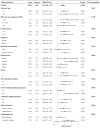Correlation of Maternal Vitamin D Status in Early Pregnancy and Vitamin D Supplementation during Pregnancy with Atopic Dermatitis in Infants: A Prospective Birth Cohort Study
- PMID: 38999915
- PMCID: PMC11243106
- DOI: 10.3390/nu16132168
Correlation of Maternal Vitamin D Status in Early Pregnancy and Vitamin D Supplementation during Pregnancy with Atopic Dermatitis in Infants: A Prospective Birth Cohort Study
Abstract
Objective: This study aimed to investigate the association of maternal first-trimester vitamin D levels and vitamin D supplementation during pregnancy with infant atopic dermatitis (AD) and to determine the effect of variables such as mode of conception on the association.
Methods: This study was based on the Shanghai sub-cohort of the International Birth Cohort of China. A total of 4051 woman-infant pairs with singleton pregnancies were recruited. Vitamin D deficiency and insufficiency were defined as serum 25-hydroxyvitamin D concentrations of 25 and 50 nmol/L, respectively. AD in infants was assessed during the first six months using a standardized questionnaire based on the British Working Party criteria. Modified Poisson regression estimated the association between maternal vitamin D status and infant AD.
Results: The risk of AD in infants was higher in women with deficient 25-hydroxyvitamin D levels in the first trimester (RR: 1.77, 95% CI: 1.41-2.23). This increased risk was seen in naturally conceived pregnancies, but not in those conceived using assisted reproductive technology (ART). The incidence of AD decreased in infants of mothers who took multi-vitamin (RR: 0.79, 95% CI: 0.67-1.98) and vitamin D supplements (RR: 0.51, 95% CI: 0.37-0.71) compared to those whose mothers did not take any supplements. Maternal vitamin D deficiency had varying effects on AD risk based on passive smoking exposure and breastfeeding patterns.
Conclusions: Our findings highlight the importance of monitoring and supplementing vitamin D during pregnancy, especially in specific maternal populations, to reduce the risk of AD in offspring.
Keywords: assisted reproductive technology; atopic dermatitis; eczema; exclusive breastfeeding; vitamin D; vitamin D supplementation.
Conflict of interest statement
The authors declare no conflict of interest.
Figures



Similar articles
-
Maternal serum 25-hydroxyvitamin D levels and infant atopic dermatitis: A prospective cohort study.Pediatr Allergy Immunol. 2021 Nov;32(8):1637-1645. doi: 10.1111/pai.13582. Epub 2021 Jul 16. Pediatr Allergy Immunol. 2021. PMID: 34165218
-
Vitamin D supplementation for term breastfed infants to prevent vitamin D deficiency and improve bone health.Cochrane Database Syst Rev. 2020 Dec 11;12(12):CD013046. doi: 10.1002/14651858.CD013046.pub2. Cochrane Database Syst Rev. 2020. PMID: 33305822 Free PMC article.
-
Maternal vitamin D deficiency during pregnancy elevates the risks of small for gestational age and low birth weight infants in Chinese population.J Clin Endocrinol Metab. 2015 May;100(5):1912-9. doi: 10.1210/jc.2014-4407. Epub 2015 Mar 16. J Clin Endocrinol Metab. 2015. PMID: 25774884
-
High circulating folate and vitamin B-12 concentrations in women during pregnancy are associated with increased prevalence of atopic dermatitis in their offspring.J Nutr. 2012 Apr;142(4):731-8. doi: 10.3945/jn.111.154948. Epub 2012 Mar 7. J Nutr. 2012. PMID: 22399526
-
Vitamin D Supplementation during Pregnancy: An Evidence Analysis Center Systematic Review and Meta-Analysis.J Acad Nutr Diet. 2020 May;120(5):898-924.e4. doi: 10.1016/j.jand.2019.07.002. Epub 2019 Oct 25. J Acad Nutr Diet. 2020. PMID: 31669079
References
-
- Asher M.I., Montefort S., Bjorksten B., Lai C.K., Strachan D.P., Weiland S.K., Williams H., Group I.P.T.S. Worldwide time trends in the prevalence of symptoms of asthma, allergic rhinoconjunctivitis, and eczema in childhood: ISAAC Phases One and Three repeat multicountry cross-sectional surveys. Lancet. 2006;368:733–743. doi: 10.1016/S0140-6736(06)69283-0. - DOI - PubMed
-
- Hatano Y., Elias P.M. “Outside-to-inside”, “inside-to-outside”, and “intrinsic” endogenous pathogenic mechanisms in atopic dermatitis: Keratinocytes as the key functional cells involved in both permeability barrier dysfunction and immunological alterations. Front. Immunol. 2023;14:1239251. doi: 10.3389/fimmu.2023.1239251. - DOI - PMC - PubMed
MeSH terms
Substances
Grants and funding
LinkOut - more resources
Full Text Sources
Medical

